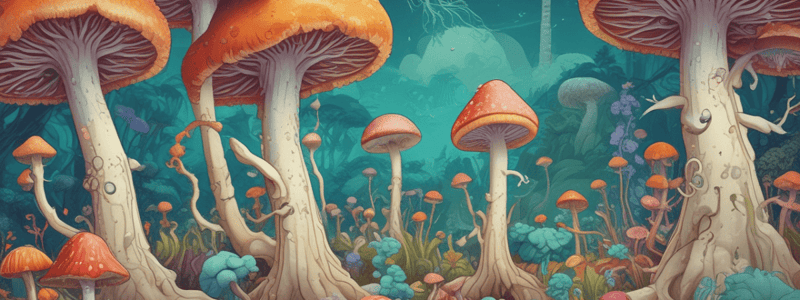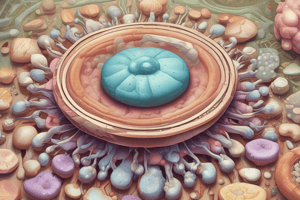Podcast
Questions and Answers
What is the most common opportunistic fungal infection?
What is the most common opportunistic fungal infection?
- Zygomucor
- Pneumocystis Carinii Pneumonia
- Candidiasis (correct)
- Aspergillosis
Which antifungal drug is used to treat mucocutaneous candidiasis?
Which antifungal drug is used to treat mucocutaneous candidiasis?
- Nystatin (correct)
- Amphotericin B
- Ketoconazole
- Griseofulvin
What is the mechanism of action of Ketoconazole?
What is the mechanism of action of Ketoconazole?
- Inhibits ergosterol synthesis (correct)
- Inhibits microtubule synthesis
- Inhibits lanosterol C14 demethylase
- Binds to ergosterol
What is the name of the fungus that causes rhinocerebral syndrome?
What is the name of the fungus that causes rhinocerebral syndrome?
What is the treatment of choice for Cryptococcosis and Candida lusetaniae?
What is the treatment of choice for Cryptococcosis and Candida lusetaniae?
What is the oldest known antifungal drug?
What is the oldest known antifungal drug?
What is the adverse effect of Amphotericin B?
What is the adverse effect of Amphotericin B?
Where do RNA viruses typically replicate?
Where do RNA viruses typically replicate?
What is a characteristic of RNA viruses that makes them prone to mutation?
What is a characteristic of RNA viruses that makes them prone to mutation?
Which of the following viruses is known to cause fifth disease?
Which of the following viruses is known to cause fifth disease?
What is the primary mechanism of replication for RNA viruses?
What is the primary mechanism of replication for RNA viruses?
Which of the following viruses is a member of the Hepadnaviridae family?
Which of the following viruses is a member of the Hepadnaviridae family?
What is the name of the disease caused by the Varicella-zoster virus?
What is the name of the disease caused by the Varicella-zoster virus?
Which of the following viruses is known to cause hand-foot-mouth disease?
Which of the following viruses is known to cause hand-foot-mouth disease?
What is the name of the virus that causes Norwalk virus syndrome?
What is the name of the virus that causes Norwalk virus syndrome?
What is the term for a fungal infection that affects the skin, hair, and nails?
What is the term for a fungal infection that affects the skin, hair, and nails?
Which fungus causes Chromomycosis?
Which fungus causes Chromomycosis?
What is the name of the disease caused by Sporothrix shenckii?
What is the name of the disease caused by Sporothrix shenckii?
What is the term for fungal infections that affect deep tissues, such as the lungs and brain?
What is the term for fungal infections that affect deep tissues, such as the lungs and brain?
What is the name of the fungal infection that is also known as Spelunker's Disease?
What is the name of the fungal infection that is also known as Spelunker's Disease?
Which fungal infection is common among patients with AIDS?
Which fungal infection is common among patients with AIDS?
What is the term for fungal infections that affect the skin and mucous membranes?
What is the term for fungal infections that affect the skin and mucous membranes?
What is the name of the fungal infection that is also known as North American Blastomycosis?
What is the name of the fungal infection that is also known as North American Blastomycosis?
What is the transmission route of Trichomonas vaginalis?
What is the transmission route of Trichomonas vaginalis?
What is the treatment for Chagas disease?
What is the treatment for Chagas disease?
What is the disease caused by Leishmania donovani?
What is the disease caused by Leishmania donovani?
What is the transmission route of Pneumocystis jiroveci?
What is the transmission route of Pneumocystis jiroveci?
What is the treatment for Toxoplasma gondii?
What is the treatment for Toxoplasma gondii?
What is the disease caused by Babesia microti?
What is the disease caused by Babesia microti?
What is the treatment for Isospora belli?
What is the treatment for Isospora belli?
What is the transmission route of Plasmodium falciparum?
What is the transmission route of Plasmodium falciparum?
What is the transmission method of Taenia saginata?
What is the transmission method of Taenia saginata?
What is the treatment for Echinococcus granulosus?
What is the treatment for Echinococcus granulosus?
Which organism is responsible for elephantiasis?
Which organism is responsible for elephantiasis?
What is the primary symptom of Schistosoma hematobium infection?
What is the primary symptom of Schistosoma hematobium infection?
What is the treatment for Fasciolopsis buski infection?
What is the treatment for Fasciolopsis buski infection?
What is the primary symptom of Diphyllobothrium latum infection?
What is the primary symptom of Diphyllobothrium latum infection?
What is the treatment for Taenia solium infection?
What is the treatment for Taenia solium infection?
Which organism is responsible for Cysticercosis?
Which organism is responsible for Cysticercosis?
Flashcards are hidden until you start studying
Study Notes
Fungal Infections
- Candidiasis: most common opportunistic fungal infection, acquired through inhalation and IV catheters
- Aspergillosis: causes asthma-like condition
- Zygomycosis: causes rhinocerebral syndrome
- Pneumocystis Carinii Pneumonia (PCP): leading cause of death for AIDS patients
Treatment of Fungal Infections
- Superficial Mycoses:
- Griseofulvin: unknown MOA, proposed to inhibit microtubule synthesis
- Nystatin: binds to ergosterol, DOC for mucocutaneous candidiasis
- Azoles: inhibit ergosterol synthesis, examples include Ketoconazole, Clotrimazole, and Tioconazole
- Systemic Mycoses:
- Amphothericin B: oldest known antifungal, DOC for systemic mycoses
- Azoles: alternative to Amphothericin B
- Life-Threatening Mycoses:
- Amphothericin B: binds to ergosterol, DOC for hospital-acquired fungal infections and all systemic infections
- Itraconazole: alternative to Amphothericin B
Viral Infections
- RNA Viruses:
- Replicate in cytoplasm
- Genome structure determines mechanism of transcription and replication
- Prone to mutation
- DNA Viruses:
- Examples include Parvoviridae, Papovaviridae, Hepadnaviridae, Herpesviridae, Poxviridae
- Classification of Viruses:
- RNA (Naked) Viruses
- RNA (Enveloped) Viruses
- DNA (Naked) Viruses
- DNA (Enveloped) Viruses
Mycoses
- Dermatomycoses/Mucocutaneous Candidiasis:
- Manifests as oral thrush, vaginitis, and diaper rash
- Subcutaneous Mycoses:
- Chromomycosis: caused by Fonseceae spp, Cladosporium spp, and Phialophora spp
- Mycetoma: caused by Pseudallescheria boydii and Nocardia brasiliensis
- Sporotrichosis: caused by Sporothrix schenckii
- Systemic/Deep Mycoses:
- Primary Pathogens:
- Coccidioidomycosis: caused by Coccidioides immitis
- Histoplasmosis: caused by Histoplasma capsulatum
- Blastomycosis: caused by Blastomyces dermatitidis
- Paracoccidioides: caused by Paracoccidioides brasiliensis
- Opportunistic Pathogens:
- Cryptococcosis: caused by Cryptococcus neoformans
- Cryptosporidiosis: caused by Cryptosporidium parvum
- Primary Pathogens:
Protozoa
- Blood and Tissue Protozoa:
- Trypanosoma brucei: causes sleeping sickness
- Trypanosoma cruzi: causes Chagas disease
- Leishmania donovani: causes visceral leishmaniasis
- Plasmodium falciparum: causes malaria
- Toxoplasma gondii: causes toxoplasmosis
- Babesia microti: causes babesiosis
Cestodes
- Taenia saginata: causes taeniasis
- Taenia solium: causes cysticercosis
- Echinococcus granulosus: causes echinococcosis
- Echinococcus multilocularis: causes alveolar echinococcosis
Trematodes
- Schistosoma mansoni: causes schistosomiasis
- Schistosoma japonicum: causes schistosomiasis
- Schistosoma hematobium: causes schistosomiasis
- Fasciolopsis buski: causes fasciolopsiasis
- Diphyllobothrium latum: causes diphyllobothriasis
Studying That Suits You
Use AI to generate personalized quizzes and flashcards to suit your learning preferences.




